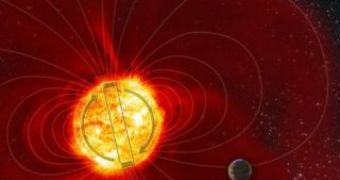It's no secret now. Planets, stars may vary their magnetic fields so severely that could eventually reverse poles. Magnetic north becomes south and vice versa. Geologic evidences strongly suggest that even our planet could have reversed its poles a number of times in the past. The Sun's magnetic field orientation slightly changes its direction every eleven years, time interval directly related to the solar activity, since magnetic fields power it. During the last few decades, scientists have been routinely engaging into strong debates in order to determine what would be the effects of such a magnetic flip taking place on Earth. While some spell doomsday, others attack a more moderate approach.
So far, there is no direct evidence that our Sun might have reversed its magnetic poles in the past, but there is a high probability that it did, and will probably do so in the future. Further still, no magnetic flip has been observed in our solar system. Albeit we are surrounded by billions of stars, shouldn't that be a good place to study the phenomenon?
The same question was asked by an international team of astrophysicists from the University of St Andrews. The subject of study: a star relatively similar to our Sun, visible with the naked eye on the night sky, located about 51 light years away from Earth, with a mass about 20 percent larger than that of our own star, slightly brighter and hotter. You can easily observe it after midnight, near the Arcturus star in the Bootis constellation.
'Tau Bootis' seems to be reversing its magnetic poles in a regular manner. The discovery has been made by astrophysicists Andrew Collier Cameron and Dr Moira Jardine from the University's School of Physics and Astronomy, which surprised the star during a magnetic flip process. Throughout a span of two years of continuous observations, astronomers concluded that tau Bootis has a much shorter solar cycle than our Sun and any other observed nearby star which may be greatly influenced by the presence of a massive planet in its vicinity.
As a result, a second team of astronomers led by Jean-Francois Donati and Clare Moutou are now trying to map the whole magnetic field of tau Bootis, study which may lead to the identification of the time interval required for a magnetic pole reversal. Not only do the new observations give a valuable insight into the magnetic engine powering the solar activity of the Sun, but they also suggest that the magnetic fields of stars interact and are greatly influenced by the magnetic fields of planets orbiting them.
For now, there is insufficient data to understand how the magnetic activity of a star works, however, the study of stars such as tau Bootis and our own Sun will eventually reveal the mystery. The last magnetic 'flip' of the Sun took place last year, when it experienced a decrease in its solar activity, registering the lowest number of sunspots in the cycle, thus announcing the beginning of a new solar cycle.
The current solar cycle began last month, when the Sun started to expose its first sunspot of the new cycle. Magnetic activity has great influence on the Sun's weather, but it is believed that it also affects the Earth's clime. Some of the past ice ages might have been triggered by a flip in the magnetic field orientation. Whether it will do so in the future, it is unknown, albeit one thing is certain, magnetic activity is intensifying and will become much frequent in the future.

 14 DAY TRIAL //
14 DAY TRIAL //